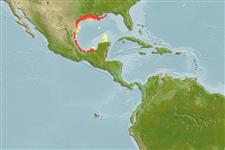Teleostei (teleosts) >
Clupeiformes (Herrings) >
Alosidae (Shads and Sardines)
Etymology: Brevoortia: From James Carson Brevoort (1818-1887), studie the fauna from Ohio and South Caroline (Ref. 45335).
Eponymy: James Carson Brevoort (1818–1887) was an American collector of coins and rare books. [...] Dr Gordon Gunter (1909–1998) was a marine biologist. [...] (Ref. 128868), visit book page.
More on author: Hildebrand.
Environment: milieu / climate zone / depth range / distribution range
Ecology
Marine; brackish; pelagic-neritic; depth range 0 - 50 m (Ref. 188). Subtropical; 30°N - 17°N, 99°W - 88°W (Ref. 188)
Western Central Atlantic: Gulf of Mexico (Chandeleur Sound, Louisiana, to the Gulf of Campeche, Mexico) but no certain records from Caribbean. Also Yucatan (Ref. 26938).
Size / Weight / Age
Maturity: Lm ? range ? - ? cm
Max length : 30.0 cm SL male/unsexed; (Ref. 7251)
Dorsal spines (total): 0; Anal spines: 0. Scutes apparent along belly. Upper jaw with distinct median notch. Pelvic fin with oblique and almost straight hind margin, the inner fin rays markedly shorter than outer fin rays when fin folded back. Pre-dorsal scales modified; scales small and numerous, those on back and above base of anal fin markedly smaller than rest. A black spot behind gill opening, but none along flank (Ref. 188). Fins dusky to yellow (Ref. 7251).
Schooling in inshore waters, including bays (possibly euryhaline). Feeds on plankton. No data on breeding (Ref. 188). Spawns during winter and possibly during early spring (Ref. 37032).
Life cycle and mating behavior
Maturity | Reproduction | Spawning | Eggs | Fecundity | Larvae
Whitehead, P.J.P., 1985. FAO Species Catalogue. Vol. 7. Clupeoid fishes of the world (suborder Clupeoidei). An annotated and illustrated catalogue of the herrings, sardines, pilchards, sprats, shads, anchovies and wolf-herrings. FAO Fish. Synop. 125(7/1):1-303. Rome: FAO. (Ref. 188)
IUCN Red List Status (Ref. 130435: Version 2024-1)
Threat to humans
Harmless
Human uses
Fisheries: highly commercial
Tools
Special reports
Download XML
Internet sources
Estimates based on models
Preferred temperature (Ref.
123201): 23.4 - 27.2, mean 24.4 °C (based on 124 cells).
Phylogenetic diversity index (Ref.
82804): PD
50 = 0.5156 [Uniqueness, from 0.5 = low to 2.0 = high].
Bayesian length-weight: a=0.00631 (0.00369 - 0.01080), b=3.02 (2.87 - 3.17), in cm total length, based on LWR estimates for this species & (Sub)family-body (Ref.
93245).
Trophic level (Ref.
69278): 2.4 ±0.17 se; based on food items.
Resilience (Ref.
120179): Medium, minimum population doubling time 1.4 - 4.4 years (Preliminary K or Fecundity.).
Fishing Vulnerability (Ref.
59153): Low to moderate vulnerability (27 of 100).
Nutrients (Ref.
124155): Calcium = 119 [69, 202] mg/100g; Iron = 1.64 [0.94, 2.75] mg/100g; Protein = 19.5 [18.4, 20.6] %; Omega3 = 0.565 [0.345, 0.904] g/100g; Selenium = 19.5 [10.5, 36.7] μg/100g; VitaminA = 10.8 [4.4, 26.2] μg/100g; Zinc = 1.32 [0.93, 1.87] mg/100g (wet weight);
